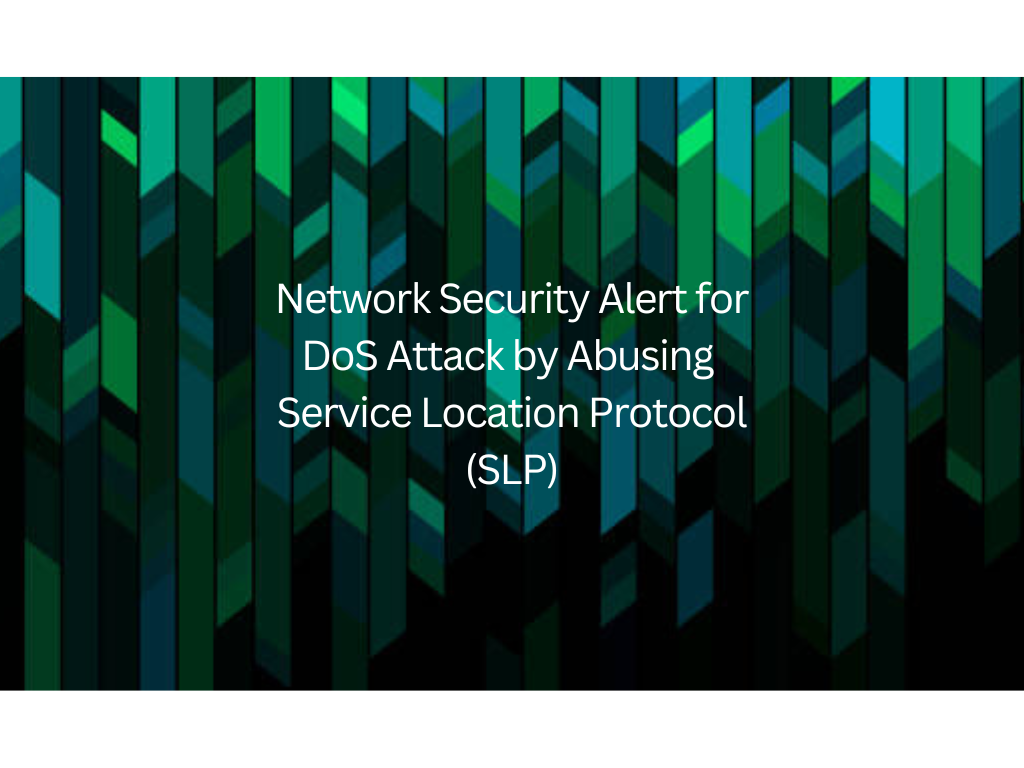The Service Location Protocol (SLP) is a networking protocol used to discover and locate network services. It is commonly used in enterprise networks to enable client devices to locate and use services provided by servers and other devices on the network.
SLP operates by sending messages between client devices and service providers to discover and locate available services. These messages contain information about the service provider, such as its IP address, port number, and other attributes.
While SLP is a useful protocol for network service discovery and location, it is also vulnerable to exploitation by attackers. The recent advisory from the Indian Computer Emergency Response Team (CERT-In) warns of a type of DoS attack that abuses SLP to disrupt network services.
Attention all Network Administrators and IT professionals:
Your organization’s network may be vulnerable to a Denial-of-Service (DoS) attack that exploits the Service Location Protocol (SLP).
CVE Name: CVE-2023-29552
SLP is a protocol used to locate and discover network services, typically enabled on network devices such as routers, servers, and printers. However, attackers can use SLP to launch DoS attacks that flood the network with false SLP packets, causing network devices to become unresponsive and ultimately bringing the entire network down.
This type of attack, known as a DoS amplification attack, works by amplifying the amount of traffic sent to the network through the use of SLP, generating a large number of packets that can overwhelm network devices and make the network unavailable to legitimate users.
To protect against SLP-based DoS attacks, network administrators and IT professionals must take immediate action to secure their networks. Here are some steps you can take to protect your organization:
- Disable SLP where it is not necessary.
SLP is not always necessary for network devices to function properly. Therefore, disabling SLP on devices that do not require it can help to prevent DoS attacks. Identify the devices that require SLP and disable it on those that do not.
- Block SLP traffic at the network perimeter.
Another option is to block all SLP traffic at the network perimeter. This can be done by configuring firewalls and routers to block SLP packets, preventing them from reaching network devices.
- Implement access controls.
Implement access controls that restrict the ability of unauthorized users to send SLP packets to network devices. This can be done by configuring devices to only accept SLP packets from trusted sources, limiting the potential for attackers to launch DoS attacks.
- Monitor network traffic.
Monitor network traffic for signs of SLP-based DoS attacks. An increase in SLP traffic, especially from sources that are not typically associated with SLP traffic, can be an indication of an ongoing attack. In addition, monitor for other signs of unusual network activity that may be indicative of a DoS attack.
- Keep software up to date.
Keep network devices and software up to date with the latest security patches and updates. Attackers often exploit known vulnerabilities in software to launch DoS attacks, so keeping devices updated can help to prevent these attacks.
- Have a response plan in place.
Have a response plan in place in case of a DoS attack. This plan should include procedures for identifying the attack, mitigating its effects, and restoring network services as quickly as possible.
In conclusion, DoS attacks that exploit SLP can have severe consequences for organizations. By taking proactive steps to secure your network, you can reduce the risk of an attack and minimize its impact if one occurs. Implementing the measures outlined above can help protect your organization from SLP-based DoS attacks and ensure the availability of network services for legitimate users.




